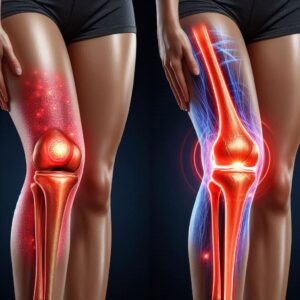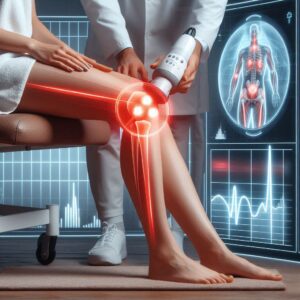Discover the Transformative Benefits of Red Light Therapy for Effective Knee Pain Relief
In recent years, red light therapy has gained recognition as a groundbreaking alternative treatment for various health issues, particularly for individuals experiencing debilitating musculoskeletal disorders. The focus on relieving knee pain and associated inflammation is essential, as these ailments affect millions of people globally, drastically diminishing their quality of life. This non-invasive therapy employs specific wavelengths of light that penetrate the skin, effectively stimulating vital cellular activities. By boosting the body’s natural healing capabilities, red light therapy presents a hopeful solution for those struggling with chronic pain and mobility limitations concerning the knee. For many, this therapy represents a beacon of hope in their quest for improved knee health and overall wellness.
As our global population ages, the prevalence of conditions like osteoarthritis and injuries from sports activities continues to climb, creating an urgent need for safe and effective treatment alternatives. Red light therapy emerges as a versatile solution, appealing to both healthcare professionals and patients alike due to its substantial therapeutic advantages and minimal side effects when compared to pharmaceutical treatments and invasive interventions. This article delves into the fundamental principles of red light therapy, highlights its specific benefits for rejuvenating knee health, and offers actionable guidance for its effective use, ultimately equipping readers with a thorough understanding of how this innovative approach can improve knee health across diverse demographics.
Essential Insights into the Benefits of Infrared Light Therapy for Knee Health Improvement
- Red light therapy serves as a non-invasive treatment, utilizing low-level red light to enhance knee health while efficiently alleviating pain and inflammation.
- This revolutionary therapy boosts the body’s natural healing processes by improving blood circulation and reducing inflammation within the knee joint.
- Key advantages of infrared therapy for knee rejuvenation include enhanced mobility, lowered pain levels, and accelerated recovery from knee injuries.
- The scientific foundation of red light therapy lies in its ability to stimulate cellular energy production and decrease oxidative stress in the knee joint.
- To achieve optimal results in knee revitalization, it is vital to concentrate the treatment on the affected area using a specialized red light therapy device for the recommended duration during each session.
 Thorough Examination of How Red Light Therapy Alleviates Knee Pain and Inflammation
Thorough Examination of How Red Light Therapy Alleviates Knee Pain and Inflammation
The effectiveness of red light therapy is rooted in its extraordinary capability to boost cellular activity through a process referred to as photobiomodulation. When specific wavelengths of red and near-infrared light are applied to the skin, they penetrate deeply into tissues, significantly amplifying cellular energy production. This crucial process occurs primarily within the mitochondria, commonly known as the cell's powerhouse, where light energy is converted into adenosine triphosphate (ATP), the vital energy currency for cellular operations. The resulting increase in ATP levels enhances overall cellular functionality, which is vital for effective tissue repair and regeneration.
As ATP production rises, the availability of energy increases, which can play a significant role in alleviating knee pain and inflammation, providing essential relief for those experiencing chronic conditions. Numerous scientific studies validate the effectiveness of red light therapy in modulating inflammatory responses throughout the body. By influencing the release of various cytokines and growth factors, this therapy effectively reduces swelling and promotes the healing of damaged tissues. The anti-inflammatory effects of red light therapy are particularly beneficial for individuals dealing with conditions such as arthritis or tendonitis, where inflammation is a critical factor contributing to pain and limited mobility. As a result, many users report notable pain relief and significant improvements in their overall range of motion and quality of life.
 In-Depth Exploration of the Comprehensive Advantages of Infrared Therapy for Knee Health
In-Depth Exploration of the Comprehensive Advantages of Infrared Therapy for Knee Health
The benefits of red light therapy extend far beyond simple pain relief; this innovative treatment fosters a holistic approach to knee revitalization that promotes overall joint health and functionality. One of the primary advantages of this therapy is its ability to enhance circulation in the affected areas. Improved blood flow plays a crucial role, as it not only delivers vital nutrients and oxygen to the tissues but also assists in eliminating metabolic waste products that can build up during injury or inflammation. This enhanced circulation not only accelerates the healing process but also contributes to the long-term health of the joint by ensuring that the knee remains well-nourished and resilient against future injuries.
Additionally, red light therapy stimulates collagen production within the knee joint, which is essential for providing structural support to cartilage, tendons, and ligaments. By activating fibroblasts, the cells responsible for synthesizing collagen, red light therapy strengthens these connective tissues, thereby decreasing the likelihood of injury and degeneration over time. This regenerative quality is especially beneficial for athletes and individuals engaged in physically demanding activities, as it enhances recovery and optimizes performance levels. Ultimately, the multifaceted advantages of red light therapy make it an invaluable tool for anyone seeking to rejuvenate their knee health and significantly improve their overall quality of life.
Scientific Evidence Supporting the Mechanisms of Red Light Therapy for Optimal Knee Health
The scientific principles underpinning red light therapy are supported by extensive research investigating the effects of light on biological systems. Photobiomodulation has been rigorously studied across various fields, including dermatology, dentistry, and orthopaedics. The wavelengths utilized in red light therapy, which range from 600 to 1000 nanometers, are particularly effective at penetrating human tissue without causing thermal damage, making it a safe option for sensitive areas such as the knees.
A multitude of clinical studies have confirmed the efficacy of red light therapy in alleviating pain and inflammation associated with knee conditions. For example, research indicates that individuals suffering from osteoarthritis experience significant improvements in pain levels and functional mobility after participating in a series of red light therapy sessions. These findings are further supported by objective measurements, such as reduced joint stiffness and enhanced range of motion.
As ongoing research continues to validate the advantages of red light therapy, it is increasingly being integrated into standard treatment protocols for knee health. This incorporation offers patients a scientifically supported method for managing their conditions, further solidifying the credibility and appeal of this groundbreaking treatment.
Your Complete Guide to Effectively Incorporating Red Light Therapy for Knee Revitalization
Integrating infrared light therapy into your knee revitalization regimen is a straightforward process that can easily blend into your daily routine. Typical therapy sessions usually last between 10 to 20 minutes and can be performed several times each week, depending on individual needs and the recommendations of healthcare professionals. Treatment can be delivered using handheld devices or larger panels specifically designed to target extensive areas like the knees.
It is crucial for patients to ensure they are comfortably positioned, with the device positioned at an optimal distance from the skin to maximize light absorption while minimizing any discomfort. Prior to commencing treatment, it is advisable to consult with a healthcare provider to evaluate individual conditions and customize a regimen that addresses specific needs. During therapy sessions, patients may feel a mild warmth or tingling sensation as the light penetrates the skin; this sensation is generally well tolerated and not associated with adverse effects.
Consistency plays a vital role in achieving the best outcomes with red light therapy; thus, establishing a regular schedule can significantly enhance the therapeutic benefits over time. As patients begin to notice improvements in their symptoms, they may find it increasingly easier to participate in physical activities that were previously limited due to pain or discomfort, paving the way for a more active and fulfilling lifestyle.
Inspirational Success Stories Highlighting the Efficacy of Red Light Therapy for Knee Pain Relief
The practical application of red light therapy has yielded numerous inspiring success stories that highlight its transformative effects on knee health. One notable case study involves an active 55-year-old woman experiencing chronic knee pain due to osteoarthritis. After several weeks of dedicated red light therapy sessions, she reported a remarkable reduction in pain levels and an enhanced ability to engage in activities she had previously avoided, such as hiking and cycling. Her experience underscores the potential of this innovative treatment to restore physical function and significantly enhance overall quality of life.
Another compelling example features a former athlete who endured multiple knee injuries throughout his professional career. Despite undergoing various treatments—ranging from physical therapy to corticosteroid injections—he continued to suffer from debilitating pain that severely restricted his mobility. Following the incorporation of red light therapy into his rehabilitation program, he experienced extraordinary improvements in both pain management and joint function. His story serves as a powerful testament to the efficacy of red light therapy as a viable treatment option for individuals facing persistent knee challenges, illustrating how it can facilitate recovery and markedly improve overall wellness.
 Proven Strategies for Seamlessly Incorporating Red Light Therapy into Your Knee Care Routine
Proven Strategies for Seamlessly Incorporating Red Light Therapy into Your Knee Care Routine
Incorporating red light therapy into your knee care regimen can be both simple and rewarding when approached with intention and consistency. To start, it’s essential to create a dedicated therapy space that is free from distractions. Establishing a calming environment can enhance the overall experience and encourage regular use of the therapy.
Setting clear goals—such as pain reduction or increased mobility—can also serve as motivation and aid in tracking progress over time. Moreover, complementing red light therapy with other beneficial practices can amplify its effects. Engaging in gentle stretches or exercises before or after therapy sessions can further enhance circulation and flexibility in the knee joint, maximizing the positive outcomes of the treatment.
Additionally, maintaining a balanced diet that includes anti-inflammatory foods can support joint health and optimize the benefits of red light therapy. By adopting a holistic approach that combines various strategies alongside this innovative treatment, individuals can significantly enhance their knee health journey and create a pathway for lasting improvements in their quality of life.
Your Ultimate Resource: Frequently Asked Questions About Red Light Therapy for Knee Pain Relief
What is red light therapy, and how does it function?
Red light therapy for knees is a non-invasive treatment that utilizes low-level red light to effectively alleviate pain and inflammation, promote healing, and enhance overall function in the knee joint. By harnessing specific wavelengths of light, this therapy activates cellular processes that lead to improved recovery and health.
In what ways does red light therapy specifically benefit knee health?
Red light therapy energizes the mitochondria within the knee joint cells, thereby increasing energy production and encouraging tissue repair. This process alleviates pain and inflammation while enhancing mobility and overall knee function, making it a valuable option for various knee conditions.
What are the principal benefits of red light therapy for knee health?
The advantages of infrared light therapy may include pain and inflammation reduction, improved range of motion, accelerated recovery from injuries, and enhanced overall knee joint function. This multifaceted approach to knee health makes red light therapy especially appealing to those looking to improve their quality of life.
Is red light therapy a safe option for treating knee issues?
Generally, red light therapy is considered a safe and non-invasive treatment for knee pain and inflammation. Unlike other interventions, it does not involve the use of drugs or surgical procedures, and there are typically no known side effects associated with this therapy, making it a low-risk option for those seeking relief.
How is red light therapy administered for knee conditions?
Red light therapy for knees can be delivered using a handheld device that emits low-level red light. The device is placed directly over the skin of the affected knee, with treatment duration typically guided by a healthcare professional to achieve optimal results.
Is red light therapy effective for all knee conditions?
While red light therapy has shown considerable promise in alleviating pain and inflammation in the knee joint, its effectiveness may vary based on the specific condition being treated. It is essential to consult with a healthcare provider to determine the appropriateness of red light therapy for an individual's knee condition.
Brought To You By Knee Pain Therapy
The Article: Red Light Therapy for Knee Pain appeared first on https://mcrtherapies.co.uk
The Article Red Light Therapy: Alleviate Knee Pain Effectively appeared first on https://mcrtherapies.com
The Article Red Light Therapy for Effective Knee Pain Relief Was Found On https://limitsofstrategy.com



Comments are closed